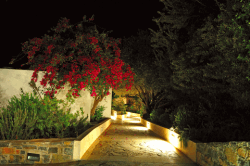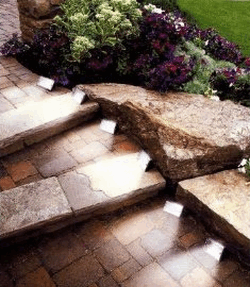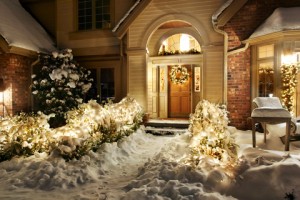Outdoor Path Lighting: Attractive Functionality
Outdoor path lighting is primarily functional, but can provide attractive patterns.
Outdoor path lighting provides both style and utility to your paths and walkways. While one of the most common ways of lighting paths is to use flood lighting, I will show a number of different options that provide lighting that is more attractive, yet still provides the safety and utility provided by single, brighter sources of lighting.
Information Versus Illumination
There are two different ways that outdoor path lighting can be used to provide safety and utility for those in your outdoor spaces at night. In fact, they are two completely different types of lighting, and play slightly different roles:

Proper path lighting both tells and shows people the location of the path.
- Information lighting: The purpose of information lighting is to tell yourselves and your guests where they should walk in order to be safe. In the case of outdoor path lighting, information lighting will usually hug the sides of the path or the lip of the stairs. In this way, your guests will know exactly where the path ends, because they will see its outline. Note, however, that information lighting does not itself illuminate the path. Its function is a rational one. Animals, for example, would have no idea what the information lighting means.
- Illumination: Illumination provides light to the path directly, so that people walking can see the surface on which they are travelling. Illumination allows people not only to understand where the path is going, but to be able to see little cracks and pavestones that might provide hazardous if they were not properly illuminated. In addition, illumination can allow your paths to continue to be attractive at night, if you use such surfaces as classic paving stones.
When lighting a path, it is important to have both information lighting and illumination. Solely using information lighting could be hazardous if your visitors trip on any small obstructions or obstacles that have made their way onto your paths. On the other hand, solely using illumination can be hazardous because, the second that someone looks away from the path, they might lose track of where it is and trip. Further, solely using illumination is less attractive, as it does not blend your lighting design with the rest of the design of your garden.
A Special Note On Stairs

Notice how placing lights on each individual stair clearly illuminates each while keeping them distinct. This model is available at Amazon
Information lighting is especially important on stairs. For the most safety, you should consider using lights that mark each stair individually for people going both upwards and downwards. When going upwards, this is fairly easy, as a strip of light or one or two small lights on each vertical surface tell people exactly where the stairs are. Going downwards, these solutions will work fairly well, as there will be breaks in the lighting in each stair. Alternatively, you can use small points of light on the side of each stairway.
If you don’t choose to use information on stairways, it is important to make sure that the lighting does not come from above the top of the stairs. When this is the case, if the shadows of each stair covers the entire stair below, it will make the stairs themselves all but invisible. Instead, make sure that the lighting comes from above the bottom of the stairs. This way, the stairs are illuminated. It is still important to use some marker to highlight the edge of the stairs, or the stairs will blend in with one another.
Number of Light Sources
As mentioned above, one of the most common ways of providing outdoor path lighting is to use a single bright light source. Aside from the lack of information lighting, it also provides the problem that the source of light needed to light pathways is simply too bright to blend well with the rest of your lighting design.
This is a general problem for all sources of lighting, whether indoor or outdoor. Using a single source of light doesn’t make things brighter, because we perceive contrast, not brightness. Instead, everything else just seems dimmer. In fact, outdoors, a single light source can actually be dangerous because if someone were to look at the light source, the person would be temporarily blinded.
It would also make it nearly impossible to blend your outdoor path lighting with the rest of your light sources. Unless you plan to light your yard entirely with flood lights, which would be unattractive, any other sources of light would look dim by comparison. In fact, it would simply wash out the entire rest of your lighting design.
If you should choose to use a flood light, make sure it is on a side path that is isolated from the rest of your outdoor lighting design. However, I do not recommend even this.
Illuminating Garden Details
An important thing to consider when choosing outdoor path lighting is just how many objects you want to illuminate using your light sources. If you wish to simply illuminate your path and leave the rest of your yard to be illuminated by other sources, small, downward sources of light will fulfil this role just fine. Alternatively, if you use illuminated pavers, lit stones that serve both as illumination and information lighting, then you will not illuminate very much by having them.However, this is not your only choice. Another option is to use your path lighting as a source of general illumination as well. In this case, you will want to use lights that spread light in all directions. A common example of this are small post lights that shine light only sideways. The light spreads out in all directions, so not only is your path lit, but the decorations around the path are lit just as well.
If you are in an area with dark sky laws, you may want to consider having taller outdoor path lighting. Dark sky laws do not allow people to shine light upwards, limiting light only to the vertical plane and, in some cities, only to light that shines below the vertical plan. In such a case, you might even consider something like solar lamp post lights, which provide not only widespread illumination, but provide attractive lighting fixtures themselves.
Putting It All Together
Outdoor path lighting can easily provide you with attractive and functional lighting, but there are a few important principles to consider in advance:
- Your lighting should provide a combination of information lighting and illumination.
- Multiple light sources provide lighting that blends better with the rest of your lighting design.
- Outdoor path lighting can also be used to provide some illumination for your yard as a whole.
- If you have dark sky laws in your area, you will need to have taller fixtures if you wish to provide general illumination.
By combining form and function, outdoor path lighting can provide an attractive and safe part of your outdoor lighting design.
